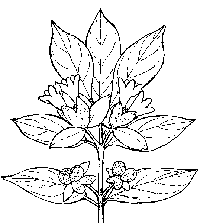Black Twinberry – Dipsacales Caprifoliaceae Lonicera involucrata
 |
 |
 |
 |
Identification & Description:
A decidious shrub growing to 1.2m at a medium rate. It is hardy to zone 4 and is not frost tender. It is in flower in May, and the seeds ripen from July to September. The flowers are hermaphrodite (have both male and female organs) and are pollinated by Insects. We rate it 2 out of 5 for usefulness.
Black Twinberry couldn’t be better named. The fruit appears in pairs, and is such a deep dark purple that it is for all intents black. These fruits are set off by showy bright red bracts.
Because the little yellow pairs of flowers appear throughout spring & summer, the fruits are also continuous through late spring and summer.
The plant prefers light (sandy), medium (loamy) and heavy (clay) soils. The plant prefers acid, neutral and basic (alkaline) soils. It cannot grow in the shade. It requires moist soil. The plant can tolerates strong winds but not maritime exposure.
he Black Twinberry grows along ocean beaches and in sand dunes. Once drought tolerant is established, this species does well in the Pacific Northwest gardens. It will tolerate growing in a wide variety of soils. However, it will flower and fruit better with irrigation during our drier months of summer.
The plant used to be used for various things. Even thought the berries are bitter tasting, they are edible. The berries were also once used as a rub-on dye to prevent the hair from turning gray. Native Americans also used it as a black pigment for other reasons. The twigs and stems were used for medical reasons such as digestion problems and as a contraceptive. The black twinberry isn’t used for medical reasons anymore.
The black twinberry was also known as “bear berries” or “grizzly berries”. Freshly squeezed juice from the berries was used in sore eyes. When the berries were not in season, the inner bark was soaked in water and the milky solution that resulted was used instead. Infusions of the inner bark were used for eye infections. The Wet’suwet’en boiled the leaves and used the liquid to bathe sore eyes, or applied the crushed leaves as a poultice to open sores.
Characteristics
erect to straggly shrub, 0.5-2 metres tall
leaves are short-stemmed, somewhat elliptical to broadly lanced shaped, pointed, with hairy undersides
yellow, tubular flowers found in pairs
shiny black “twin” berries cupped by two deep purplish maroon bracts
Habitats and Possible Locations
Woodland, Sunny Edge, Dappled Shade.
Fruit.
Fruit – raw or dried. A pleasant taste. Not tasty enough to be widely sought. The only form we have tried has an incredibly bitter taste. The fruit is about 8mm in diameter.
Other Uses
Dye; Hair.
A purple dye is obtained from the fruit. It is grey when tin is used as a mordant.
The berries are rubbed onto the scalp as a hair tonic. It is said to prevent greyness. (don’t mix the berries with tin though!!)
Cultivation details
An easily grown and very tolerant plant, succeeding in any fertile soil, and preferring a good moist soil in a sunny position. It produces less fruit when grown in the shade. Plants have proved to be quite wind resistant when growing on an exposed site in Cornwall.
Plants are hardy to about -25°c.
Closely allied to L. ledebourii.
There are some named forms, developed for the ornamental garden. ‘Humilis’ is a smaller form and ‘Serotina’ is later flowering.